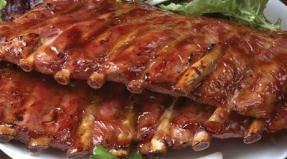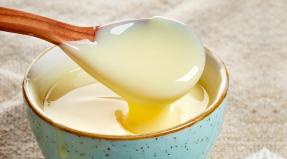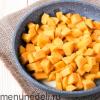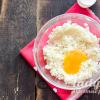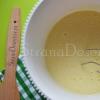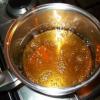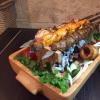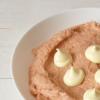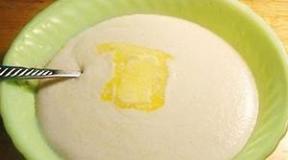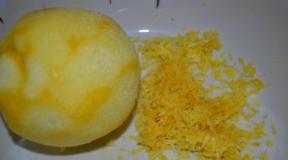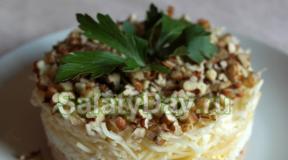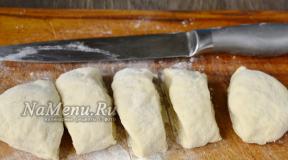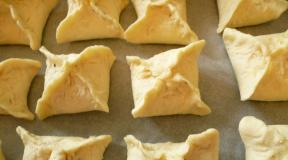How to cook Beshbarmak: Best recipes with lamb, beef, horseback, duck, chicken. Correctly prepare the Kazakh Besbarmak & NBSP Besbarmak National Dish
Beshbarmak is an ancient dish of Turkic peoples. It is unlikely that someone knows exactly how Beshbarmak was prepared for distant ancestors, so it is enough to adhere to the general principles of cooking and take quality products. The dish is essentially very simple - boiled meat, peculiarly sliced \u200b\u200bnoodles and very strong welded broth.
Kazakhs, for example, are traditionally prepared by Beshbarmak from lamb, and on holidays in the dish must be added to the conine. Present in the recipe onions and greens. In general, everything is quite simple, tasty and very satisfying.
It is not difficult to cook such a dish, you only need to place time, because the strong broth is boiled for quite a long time. I propose to cook Beshbarmak on three recipes: from lamb, from chicken and beef.
Step-by-step recipe Beshbarmak in Kazakhs from lamb
Kitchen tools: Rock, saucepan.
Ingredients
Cooking meat cooking beshbarmaka from lamb
Preparing lepseki

Cooking Luk

College Beshbarmak

Bon Appetit!
Lamb Recipe Forest
The video shows how to cook beshbarmak From lamb in the Kazakh recipe.
Step-by-step recipe for a beshbarmaka from chicken with a photo
Time for preparing: 2 hours.
Number of portions: 6.
Kitchen tools: Rock, pan, frying pan.
Ingredients
Cooking beshbarmaka chicken
Cook broth

Recipe test on Beshbarmak

Preparing lepseki

Preparing refueling

College Beshbarmak

When applying, each put a brow with a broth.
Video recipe Beshbarmaka from chicken
All that is described in the recipe can be viewed on the video.
Step-by-step recipe Beshebarmak from beef and lamb with photos
Time for preparing: 4 hours.
Number of portions: 6.
Kitchen tools: Rock, pan, sieve, frying pan.
Ingredients
Meat should be on the bone.
Preparation of beef and lamb
- 1.5 kg of beef and 1.5 kg of lamb lay in a saucepan and pour water. Cook at least 3 hours. Do not forget to remove foam.

- In 300 g of flour put a quarter of a teaspoon of salt. We smash an egg in flour.

- Gradually, pouring water, knead the very cool dough. The knead will have at least 15 minutes. After the dough is imagining, it will be quite rolling. We cover the finished dough and leave it for half an hour.

- 2 hours after the start of the cooking of the broth, we put a couple of bulbs into it, a dozen peas of fragrant pepper, 3 laurel sheets. Solim broth to taste.

- From the dough roll over several subtle reservoirs.

- Cut the layers with small rhombuses.
- Ready meat remove from broth. The broth is filtering through the sieve.

- Cut meat with small pieces.

- 4 bulbs cut into thick rings. From the broth we collect fat, and the broth is filtering again through the napkin.

- On the fat, which we collected from the broth, prepare onions, passing it in a pan.

- Singing a part of the broth, cook the dough pellets in it. I spread the pellet, onions and meat on the dish.

Broth break over the portion of the glands and put a parsley into it.
Video recipe cooking beef and lamb
The video presents a great recipe for cooking beshbarmak from beef and lamb. You can also get a lot of useful information about this old dish.
I make an emphasis on the fact that whatever meat you can use in Beshbarmak, bones must be present in it and a little fat - without them, the broth will not be welded and tasty. Of course, Konified, but it is probably problematic, but it is probably problematic, and not everyone loves this grade of meat. Therefore, you can do lamb, beef or chicken. If possible, the gourmets are recommended to add Schuhuk broth when cooking - the famous Kazakh sausage.
Another advice - when the meat is boiled for a long time, it should not touch the hot bottom of the pan. To avoid it, put something on the bottom of the pan, for example a ceramic plate.
If you like the recipes of national cuisines, I recommend to prepare -aase from beef or pork, a very spicy taste has -Aza from the turkey. Still, try-pitstroogans from beef- or chicken or surprise guests with an exquisite recipe -Befstrohanov from the liver.
If you never ate Beshbarmak, prepare it in Kazakh, and I assure you will be just shocked by the fact that a simple dish has such a rich taste and aroma. Share your impressions in the comments.
What is Beshbarmak? This is a traditional recipe in Kazakhstan, as well as a national dish. The Kazakh people were originally nomadic and moved along the large territories with their animals. To prevent the transfer of too large cargo, the tribes took with them only essentials, including large iron cauldrons, yurts and other personal belongings.
Beshbarmak is a traditional dish, because it is not only the first, but also the second at the same time. Not soup and not roast, but something unique. Usually women are preparing. The main ingredients are meat and sheets of boiled dough with a small amount of broth. As a rule, horse or lamb is used. For this dish, the meat is preparing for a long time, bothering it. Usually, Beshbarmak is fed at the celebrations and national holidays.
So what is Beshbarmak? This is actually the main meat dish, which includes noodles. Today it can be called and soup, which is prepared not only from noodles and boiled meat, but also with potatoes, chicken or duck, pork and even fish. However, these are just modern additions and variations. In fact, Beshbarmak does not belong to the first or to the second dish, but represents the average that unites them. This is a full meal.
Beshbarmak is translated as "food for five fingers." In Central Asian countries, this dish is served in a large cup, and holding it in hand, eating without the use of cutlery.
What are the features of cooking?
A special or unique step in the preparation of this dish lies in the fact that the meat is brewed for a long time. It is just a traditional oriental way to prepare it. Another unique feature of Beshbarmak is that he is eating with his fingers. Using such an unusual dish with hands, without the use of cutlery is a violation of etiquette in most European countries. However, Kazakhstan is a centuries-old tradition. As you can see in the photo, Beshbarmak consists of large ingredients, so there is it without the use of instruments is quite convenient.
What do you need?

For the preparation of Beshbarmak, special equipment is not required. It is necessary only a saucepan for cooking meat and noodles, as well as a rod and a knife for making a pasta. These items will easily find each mistress. Ingredients for dishes can be bought at any store, since lamb or beef will easily replace the horse. Thus, Beshbarmak is a simple dish. You can easily prepare it to bring some eastern culture to your home.
What meat to choose?
The above is an explanation of what Beshbarmak is. This is a traditional nutrition element of nomadic tribes that lived in Central Asia, mostly Kazakhs and Kyrgyz.
As already noted, the literal translation of the word "Beshbarmak" is "five fingers". In Asian cuisine, this dish is mostly cooked from horse meat. However, in our days, people adapted it to their own tastes, using other types of meat, including camel, chicken and even fish. Certain types of spices are also added to modern dishes, which were originally absent in the recipe.

In the original version of Beshbarmak, an ideal is used a piece of the back (cereal) of a horse or a ram. Since today to find these types of meat is difficult for sale, you can use a simplified recipe that uses easily accessible and common ingredients.
Classic Beshbarmak: Recipe at home
Be sure to prepare all the ingredients in advance and read the recipe to the end before starting something to do. It will help you organize the cooking process as it will be more convenient.
The number of ingredients is sufficient for eight portions of the finished dish. So, you will need:
- lamb or beef with bone - approximately 1.5 kg;
- salt is not too much to taste;
- 2 medium-sized bulbs, purified and sliced \u200b\u200brings;
- ground pepper.
For test take:
- two eggs (large);
- 200 ml of water;
- Salt - 0.5 spoons of tea;
- simple flour - about 600 grams.
Where to begin?
A step-by-step peshbarmak recipe looks like this. First of all, put meat into a fairly deep saucepan, pour it cold clean water so that it covers it completely. Bring to a boil, constantly removing the foam, otherwise the broth will not be clean and transparent. Reduce the heating when it starts to boil. Cover the lid, after removing the fat from above and retaining it in a separate dish. In the future, you can use it to make a sauce (this is if you are not against the addition of fat in food). Meat should be prepared approximately 2-2.5 hours.

Meanwhile, prepare the dough. At the same time, do not forget to follow meat, because it will boil all the time. Check its readiness from time to time. It is very important because the cooking time may differ depending on the age of the animal, the conditions of its content, the diet, when and how it was clogged and how the product was stored.
In a bowl, mix the sifted flour (approximately 300-400 grams), eggs (you can beat them slightly before adding to flour), salt and water. Check the dough if you need to add more flour. You have to get a dense ball that should be wrapped with a film and leave approximately half an hour.
How to do noodles?
In the photo, Beshbarmaka can be seen that noodles usually has a rectangular shape. To make it, you must sprinkle the working surface of the sifted flour and divide the dough on it to pieces of the same size (approximately with an average apple). After that, holding the countertop, roll each dough fragment into a rather thin layer with a thickness of about 2 mm. Continue sprinkling it with flour so that it does not stick to your hands or work surface. Good dough must require a little effort to rolling.
Cut it into squares of approximately 10x10 cm in size. Leave them on the table top, slightly covered with flour. Each square should be at some distance from the adjacent product. By the time the noodles need to prepare, the dough should be a little dried.

30 minutes before the meat is ready, add half of the bow (sliced \u200b\u200bin the shape of a rings), pepper and salt into the pan. When it is ready, pull it out and postpone. Meat should be easily separated from the bone.
End of cooking
At this time, make the sauce. Pour the fat mass that you have gathered during the cooking of meat, over the rest, pepper and salt in a separate dish. Boil the mixture on slow heat about 7-8 minutes.
Start cooking the dough in batches in the meat broth, approximately 7-8 minutes. Lay out the finished noodles on a large plates, leaving space in the center for meat. Then put the pieces of meat, sliced \u200b\u200blarge, on top all pour the sauce. If you want, sprinkle every portion greens. Beshbarmak is ready, serve it to the table is very hot.
Some people also love broth left after cooking meat. In this case, it is not necessary to fully use it for cooking noodles. Part of the broth drain and strain, it will remain for the feed on the table.
Are there any other traditional options?
Having studied the above-described recipe, you can easily understand what Beshbarmak is. This is one of the most popular dishes in Central Asia, which is loved and often prepare many fans of east food. It is not associated with a kitchen of any particular country, it is possible to confidently argue that this is a Muslim traditional dish in general. To be more accurate, Beshbarmak was invented by nomads, including Bashkirs, Tatars, Kazakhs, Kyrgyz and other nations.

In countries where Beshbarmak is very popular, it is preparing for various holidays, without him a solemn table is not considered complete, completed. As a rule, it is served in a large common plate, in which noodles and meat is beautifully distributed, and decorated with greens. Separately served in small bowls left after cooking meat broth.
Kushanye has a specific taste, typical of only this dish, which is associated with the technology of its preparation and feed. Below is a festive recipe with a photo of Beshbarmak at home. In order to prepare the dough, you need to take:
- 600 grams of flour;
- 200 ml of water or broth;
- two eggs;
- half a teaspoon salt.
For meat component:
- 4 liters of cooking water;
- 1.3 kg of lamb, or beef;
- 8 peas of pepper fragrant;
- 2 Laurel sheet;
- big bulb;
- big carrot;
- salt.
For refueling (sauce) you need to take:
- 3 bulbs;
- two beam parsley;
- glass of fat made of broth;
- black pepper.
Cooking process
How to cook beshbarmak home by traditional recipe? Rinse meat, arrange it with large slices, fold into the pan, fill with four liters of cold water, turn on the average temperature and bring to a boil. Then get the fire to the minimum level and cook the meat to such an extent so that it is very easily sided with a fork. It will take 3-4 hours. An hour before the end of its preparation, put a peeled carrot in the pan, a whole bulb, pepper and salt. The foam during cooking should be removed, and later the pop-up fat must be removed and shifted into a separate clean dishes.
To prepare the dough for noodles, you should sift flour, pour out half into a bowl, put a little whipped eggs, salt, add chilled water and knead the dough. With gradual stirring, you must add the remaining part of the flour. Proper test consistency is checked easily: when cutting, air bubbles should not be visible. Wrap it with a film or wet towel, leave half an hour.
As you can see the recipe with the photo, Beshbarmak should be with a large, but very thin noodle. To form it, cut the dough into pieces with an apple size, roll each of them very thin - 1.5-2 mm thick. Cut each layer on stripes or squares. Sprinkle the finished noodles of flour and leave on the table for a while.
Strain the broth, after reaching all the vegetables and spices from it, and the meat divide into small pieces of fibers. Cut onions on the rings, half put in the fat removed from the broth when cooking meat, salt and boil until soft. The remaining onions put in a colander, and hide the boiling broth. Then slightly shake it and sprinkle with fresh ground pepper.
In a separate pan, pour four buckets of broth, add water, salt, bring to a boil and put strips from the test. Boil them at the middle level of fire until ready. They should be booked as pasta, to the degree of "Al Denten", in no case do not digest. Throw off the boiled dough into a colander and mix with the fried onion, while the noodles should not be glued.
How to serve Beshbarmak?
Take a large flat dish, put a boiled dough with onions in it, add meat and blanched onions with pepper. Festive Beshbarmak at home is ready. On individual cups, run the broth (it should turn out to be transparent and clean), sprinkle it with sliced \u200b\u200bherbs (dill, parsley, kinza, green onion or any other greenery to taste).

Meat for this dish can be any: horse, beef, lamb and even camel meat, but it must be definitely young and fresh.
It is important not to digest the dough, and also to roll it is quite thin - the digested and thick pieces will make the dish not as it should be.
In order to significantly simplify the method of cooking Beshbarmak, you can use the finished sheets of the dough designed for Lazagany, which are sold in all major stores. In addition, you can serve it with pasta or boiled rice, as soon as you cook the meat. It is also allowed to add potatoes to broth, but these options are not traditional.
If Beshbarmak is made only from lamb, then with her cooking you can add fresh tomatoes. To improve the taste of the broth supplied in the bowls, you can put in it chopped garlic.
Beshbarmak with chicken
As mentioned above, today this dish is prepared from different types of meat. To prepare a beshbarmak of chicken, you will need:
- 800 grams of chicken meat with bones;
- 1.5 liters of water;
- three bulbs;
- two carrots;
- salt.
For cooking noodles you need to take:
- 230 grams of wheat flour;
- glass of water;
- big egg;
- salt.
How to do it?
So, we offer you a simple and interesting recipe for beshbarmak with chicken. Fill the chicken meat with cold water, boil it for two hours. Carrots and 2 bulbs cut into pieces, slightly fry, put in a saucepan with a chicken 20 minutes before the end of cooking, then add pepper and salt.
Check the dough from eggs, flour, salt and water, leave half an hour.
Roll it into a layer with a thickness of 2 mm, then cut out on the rhombus with the sides of 3-4 cm. Boil them into a slightly salted water for 5 minutes.
Remove the chicken, onions and carrots from the broth, remove the bones and cut the meat with slices, and then put it back into the broth. The remaining onion cuts the lumps and add to the broth, cook another 5 minutes or so.
Before feeding, put in each dish several dough rhomes, meat and paint from above with a small amount of broth, sprinkle with chopped herbs. A recipe with a photo of Besbarmak at home suggests that the dish must be filed in this way.
If you use only poultry meat, but the chicken seems to you too dry and fresh, you can use duck or goose for a recipe. The process of cooking will be identical, and the taste will change significantly.
In addition, the duck can be made modern, and not the traditional version of Beshbarmak. To do this, prepare the recipe dish indicated above for chicken, but at the same time boil potatoes in broth. Serve Beshbarmak portion in the form of a soup, laying out the duck meat, noodles, potatoes and bay all this with a broth.
Is it possible to cook beshbarmak from pork?
As already mentioned above, you can use absolutely any meat. However, you must remember that the eastern peoples do not use pork in any way. Therefore, Beshbarmak from this meat will not be a traditional dish.
The Kazakh national cuisine has always been famous for meat, flour and dairy products, so Besbarmak became one of the main traditional dishes of the people. Over time, some components "Beshbarmak" changed and complemented by certain ingredients depending on geolocalization and the main activity of the population in certain regions of Kazakhstan. Traditionally, the dish is served at the solemn events, family holidays exclusively for honored guests. The period and height of the preparation of Beshbarmak is winter, since it was at that time of the year it is more convenient to store meat blanks and quietly expect the neighbors to "Bech". Also, from the beginning of winter cold weather, meat blank begins for the entire winter ("Sogy"), which affects the choice and preference in the dish in the population. The feed "Besbarmak" is a responsible and integral part of any important event in a circle of close friends and relatives. Also, one of the most famous dishes that are offered to tourists in Almaty are Kuyrdak and Beshbarmak. Of course, it is impossible to feel the real taste of these dishes, without having been in this beautiful steppe country, but you can try to prepare them at home, surprising guests with an unusual taste and specifics of Kazakh cuisine.
History and meaning of the name "Beshbarmak"
From ancient times, meat was considered the main dish for nomadic cattle breeders. According to researchers, they gave the maximum variety of recipes for cooking and blank meat products. Traditional meat on coals, which is known to all so far as kebab, valen meat, smoked and other varieties of its preparation. The welded and strong sorp from the Ponkon centuries saved the Kazakh people from harsh winters and cold. And the one who ever tried the "Steppe Cur" will forever remember the refined taste of this unusual dish.
Speaking about the origin of the very name of the dish of Beshbarmak, it becomes quite interesting, since "Beshbarmak" is the national disorder of many Turkic peoples, the pronunciation of dishes varies and modifies. Initially, the name in Kazakh was "Besbarmak", in the Kyrgyz language: "Beshbarmak", on Bashkir: "Bish-Barmak". The definition is formed from the two components of the "demon" and "Barmak", which means translated into Russian "five fingers", but in everyday life, Russian-speaking residents of Kazakhstan use the original name of the dish and do not translate it literally.
"Besbarmak" or "Besbarmak"?
This question is often asked both by the local population and tourists. How is it more correct to call it a dish? Initially, the value and pronunciation of this exorbit was quite simply divided; According to the principle of the language and peoples that live in one territory or another. Since the Kyrgyz people have the meaning of the word "Besh" as a figure of "five", then the full name for this people was pretty pretty simple: "Beshbarmak". "Five" in the Kazakh language sounds a little different, as: "Bes", therefore, since ancient times, the Kazakhs were considered more correct to call a dish as "Besbarmak". Over time, the name varied and moved from one pronunciation to another. At the moment, in use of the bowl, the name is used as: "Beshbarmak". In general, it is not considered a big or rough mistake if you accidentally named any one of these options, so both are considered correct and the interlocutor must understand you.
Features of the feed and tradition
The culture of the Kazakhs is very rich in rituals inside the family. There is your "Code of Conduct" in relation to the older to younger, the matchmaker to the matchmaker, children to parents and so on. Of course, if you know the rules for the behavior of the main participants in the "hierarchy" - the part of the issues disappears by itself. The tea breaks only women and here there are also their subtleties. In the south, it is customary to pour tea to half, otherwise guests can calculate that they want to faster. In other regions, they simply try not to pour to the edges. Tobacco (big plate) with Beshbarmak usually drive the youngest men in the house, the knife for cutting meat is put on each plate. The most honorable tobacco (bass tobacco) with the best slices of meat and the head of the ram in front of the most respected guests. The senior guest should divide the head between the rest. It must be remembered that those whose father cannot be touched on the head. After the meal, the older guest should give his blessing "Bata", after which the daughter-in-law with a bowl takes. At the very beginning, the head of the Baran is served as a sign of mailing and respect. Usually, the lower part must be separated from the skull. The distribution of parts of the head is a very important ritual between guests and relatives of the feast. So, distributing the head of the Baran, it is worth following the following rules:
- Lobal part - Men
- Jaw - women
- Right ear - not served, it hides like a mascot for well-being in the family
- Well-raised teeth - a chanda to any slander and slandering at the table
Before starting the celebration, guests bring a blessing and requests to the Almighty to the well-being and a good amount of livestock at the owner in the future. Pieces are distributed depending on the status and merit of the guest, as well as its age. Next, Besbarmak himself is made!
Of course, after many years of integrating a variety of cultures in our country, the Kazakh cuisine now looks completely different. Now guests are met and pilame and marts, even the Olivier salad is not alien to our table. But we must remember that you do not cook Beshbarmak for honorable guests - it means to insult them. You can serve additional dishes to Beshbarmak, but it is impossible to replace our national dish.
To prepare dishes you need:
Before you start cooking Beshbarmak, make sure that you have a positive attitude to the preparation of this dish, as it requires patience and care from the chef. Since it has already been said that ingredients may vary depending on the preferences and economic activities of some regions of our big country, there are quite individual and all are considered individual and unique for each family. In this article, we share a classic recipe. So, let's start with the ingredients:
Cooking method
Meat for Beshbarmaka, basically, is the horse, both itself, and the prepared pre-"Kaza". "Kaza" is a traditional delicacy from horseback, by type resembling sausage. "Kaza" is manufactured by tapping a natural horse ink with horse fatty meat with Ryube (usually unwinding meat with spices and spices), and they are not stuffing, but fill meat with an edge entirely, thus getting a large semir. Kaza to boil several hours under the closer supervision of the cook. Traditionally, the separation of meat of the prerogative of men, rolling the dough and the cooking itself - the occupation of women. From the young age, girls in families are taught to racking the cakes for Beshbarmak, and the ability to prepare a delicious dish and correctly submit it to guests to guests is an unknown feature of good daughter-in-law. Konified is drunk a large piece of 2.5-3 hours until readiness. The dough is mixed out of flour and eggs with the addition of salt, it is possible on the cooled horse broth. For 2-3 hours the dough is rolled into thin juice. The onion cuts the rings poured fat broth, salt, pepper to taste (if desired, you can add a little small chopped bell pepper). The jups are boiled in the broth, laid out on the dish ("tobacco"), the meat is stacked on top (or a whole piece with bone or sliced). Then it watered all the fastened onions ("Tuzyduk"). If you wish, you can lay out "Kaza", "Card", "Schuzhuk", "Karyn", "Zhuzhuk" and sometimes fed to the bouffers and carrots in the broth. Wheat and rye flour is enough "capacious" product. Store ready-made pellets you can have a long time they are easily transported and stacked into any dishes.
A variety of beshbarmak in the regions of Kazakhstan
Since Beshbarmak is a unique dish, it is very hard to find a single recipe that all residents of the regions of Kazakhstan would use, so below you can familiarize yourself with various traditions and features in the recipes of Kazakhstan cities with the words of the residents of our grandparents.
The city of Almaty
 Beshbarmak in Almaty - Cooking secrets. In the title of this dish reflected part of the history, culture of national food treatment and indeed - in Almaty, Beshbarmak is taken by hand using all five fingers; That is, following the traditions, Kazakhs, as well as Uzbeks and Tajiks eat it during a variety of national rites. Meat cut into pieces, put in the cauldron, poured with cold water and put on fire. After the water boils, the fire must be reduced slightly and so cook until complete readiness, periodically removing the resulting foam. Somewhere in half an hour before the complete readiness of the meat, spices are added to the cauldron: a bay leaf, black pepper and salt, and also put one head of the bow. When the meat is already brewed, you can start kneading the dough. After it stands 40 minutes, you need to take the rolling pin and start it to roll into a homogeneous layer, a thickness of about one and a half years. After that, the entire reservoir should be cut into squares on the side of the side of 7-8 cm. Meanwhile, half an hour before willingness, you can throw the potatoes in the cauldron with meat. Beshbarmak in Almaty is served with potatoes, but if you do not have it, you can skip this item. So, when the meat was welded, it should be shifted into a closed dish with boiled potatoes and do the rest of the ingredients. In the second cauldron you need to put onions cut into the rings, salt from above and fill with spices, and then pour hot broth from under meat. After that, Kazan is placed on a weak fire and covered with a lid - the bow should simply languish in. Separately, the broth omit juits and cook it all until complete readiness. In the city of Almaty, Beshbarmak is supplied as follows: the pieces of the dough are laid out on a large dish, slices of boiled meat (for convenience, you can cut into smaller pieces). All this is decorated with a tommy onion rings, and boiled potatoes are laid out along the edges.
Beshbarmak in Almaty - Cooking secrets. In the title of this dish reflected part of the history, culture of national food treatment and indeed - in Almaty, Beshbarmak is taken by hand using all five fingers; That is, following the traditions, Kazakhs, as well as Uzbeks and Tajiks eat it during a variety of national rites. Meat cut into pieces, put in the cauldron, poured with cold water and put on fire. After the water boils, the fire must be reduced slightly and so cook until complete readiness, periodically removing the resulting foam. Somewhere in half an hour before the complete readiness of the meat, spices are added to the cauldron: a bay leaf, black pepper and salt, and also put one head of the bow. When the meat is already brewed, you can start kneading the dough. After it stands 40 minutes, you need to take the rolling pin and start it to roll into a homogeneous layer, a thickness of about one and a half years. After that, the entire reservoir should be cut into squares on the side of the side of 7-8 cm. Meanwhile, half an hour before willingness, you can throw the potatoes in the cauldron with meat. Beshbarmak in Almaty is served with potatoes, but if you do not have it, you can skip this item. So, when the meat was welded, it should be shifted into a closed dish with boiled potatoes and do the rest of the ingredients. In the second cauldron you need to put onions cut into the rings, salt from above and fill with spices, and then pour hot broth from under meat. After that, Kazan is placed on a weak fire and covered with a lid - the bow should simply languish in. Separately, the broth omit juits and cook it all until complete readiness. In the city of Almaty, Beshbarmak is supplied as follows: the pieces of the dough are laid out on a large dish, slices of boiled meat (for convenience, you can cut into smaller pieces). All this is decorated with a tommy onion rings, and boiled potatoes are laid out along the edges.
Besbarmak "Through Chabhanki" one of the most interesting ways to prepare Beshbarmaka came precisely from Shamalgana, instead of the juicy, the inhabitants roll up and cut a noodle with a thickness of 1.5 -2 mm and a width of 5-6 mm and after cooking is abundantly mixed with a tuduk. Tuppy, usually poured with a fat taken from a boiled kaza, or a fat broth.
South Kazakhstan region
The choice of fresh and tasty meat is a separate important point in cooking, namely in Besbarmaka blanks. In the families of the city of Shymkent, usually try to contact familiar to neighboring aules, if the fate has eaten so that there are no relatives in the neighborhood, almost every family has its own butcher in certain markets, which will always offer fresh meat and Kaz. Residents of this city belong to the choice of meat especially carefully, as it is believed that the choice of the right meat of 50 percent of the success of a delicious beshbarmak. Therefore, according to many residents, the relationship between the butcher and the buyer become close and to some extent related. Meat for the buyer is always named and orders are accepted in a few days, and even weeks before the event. Attitude towards other dishes, the inhabitants of the city are rather loyal, but the greatest preference is given to Beshbarmaka! The dough is considered a certain garnish to Beshbarmak, some residents believe that the potatoes are imposed in the traditional recipe. But more and more and more often you can meet on the tables this dish with potatoes and without cakes. Also, very often used lamb lamb (the leather of lamb is not removed from the meat).
In the Kyzylorda region, it is often prepared from rice, which is quite different from the recipes of other families in the regions of Kazakhstan.
Speaking about the program behind Dastarkhan, after a feast, usually, the entertainment part of the program begins. As nice, at the very beginning, all guests wish the owners all the best and good in their home. Following the favorable words, guests await the performances of local singers and artists. One of the most fun and unpredictable parts of the evening is the moment when guests must show a response performance by professionals. At this moment, everyone can reveal themselves in any creative manifestations! In particular honor, guests are used, which at once on rumor can remember this or that work and fulfill its owners at home.
West-Kazakhstan region
 A large abundance of fish products and activities of the population of the West Kazakhstan region had a great influence on the national dish. Many aesthet suggest that one of the most basic component of this Besbarmak is Konified, do not understand how it is possible to cook it out of fish! Namely in this area of \u200b\u200bour country, Beshbarmak is practiced from fish. Locals call such a beshbarmak: "Fishebarmak". It is preparing on the same principle as the classic, however, at the very beginning, any fish for the base is boiled, but more often Sazan or Beluga. At the same time, residents do not refuse to completely from Beshbarmak with the horse, it is also popular as
A large abundance of fish products and activities of the population of the West Kazakhstan region had a great influence on the national dish. Many aesthet suggest that one of the most basic component of this Besbarmak is Konified, do not understand how it is possible to cook it out of fish! Namely in this area of \u200b\u200bour country, Beshbarmak is practiced from fish. Locals call such a beshbarmak: "Fishebarmak". It is preparing on the same principle as the classic, however, at the very beginning, any fish for the base is boiled, but more often Sazan or Beluga. At the same time, residents do not refuse to completely from Beshbarmak with the horse, it is also popular as
fish version. True, the only difference will probably be in the ratio of the amount of meat and dough, which is served on Dastarkhan. The advantage is given to more pellets than meat. More precisely, meat on the dish is smaller than the test. In some cities, such as Aktau or Atyrau Kaza can be served separately from the main dish.
North-Kazakhstan region
 In this part of Kazakhstan, it is customary to serve Beshbarmak solely in a special wooden dish, called "Astabak", "Astau" or "Astak". Residents of Kokshetau give more preference to meat. The dough is placed in one layer on the bottom of "ASTAU" and is tightly covered with several layers of meat. Kaza is not served as cutting, it is put exclusively in the dish itself. Himself "ASTAU" is made to give high-ranking people and the most honorable guests, and this kind of gift always remains one of the most significant among the inhabitants of the North Kazakhstan region.
In this part of Kazakhstan, it is customary to serve Beshbarmak solely in a special wooden dish, called "Astabak", "Astau" or "Astak". Residents of Kokshetau give more preference to meat. The dough is placed in one layer on the bottom of "ASTAU" and is tightly covered with several layers of meat. Kaza is not served as cutting, it is put exclusively in the dish itself. Himself "ASTAU" is made to give high-ranking people and the most honorable guests, and this kind of gift always remains one of the most significant among the inhabitants of the North Kazakhstan region.
Central Kazakhstan region and East Kazakhstan region
Residents of the central and eastern parts of our republic prefer a large amount of meat (Konified, beef, lamb). "Kaza" is not cut into a separate dish, and put together with Beshbarmak. Sometimes, over the side of Sherpek. Special differences from the classic beshbarmak, these parts of the country do not have, while most of the population prefers and gives tribute to the original and classic recipe for cooking beshbarmak.
The significance of national dishes in the formation of the peoples of the world
As you have already noticed, a variety of recipes and features of this national dish is simply incredibly, and if you think about it, because it is such facts and unique little things and create a vision of the people and how diverse our views on ordinary, at first glance, dishes. For many centuries, the national dishes created and continue to create the appearance and uniqueness of the peoples of the whole world, and the study of the details and specific features of national delicacies only expands the horizons of any self-respecting modern person .. KZ and all the apicles of our country for unique recipes!
Beshbarmak is a traditional dish of Turkic peoples (Kazakhs, Kalmykov, Tajiks, etc.). Most of them were cattle and a nomadic lifestyle. I say this so that you, my dear readers, did not keep themselves with special hopes and did not represent this Kushan something sophisticated and exotic. Beshbarmak is boiled meat with self-made noodles, fastened onion. Something like Ukrainian dumplings, only disassembled. Everything is extremely simple, tasty and satisfying. As if said the hero of "Star Wars" Master iodine: "Good food."
Ingredients:
(4 servings)
- 1 kg. Beef or lamb
- 3 Lukovitsy
- 3-4 cloves garlic
- 4-5 pcs. Lavra leaf
- 10 black pepper peas
- greens for decoration
- dough:
- 250 gr. flour
- 1 chicken egg
- 1/2 Art. water
- Beshbarmak most often prepared for the holidays, and the main difference between the festive dishes from the daily nomads is an increased amount of meat. So, in Beshbarmak there should be a lot of meat! We will not talk about exotic type of horse or venison, but focus on all available beef or mutton. Of course, you can use pork, only then aloud, do not call the result of your culinary creativity by the traditional oriental beshbarmak. Another indispensable condition for meat, it should be fat.
- The meat acquired for Beshbarmak is rinsed and lay in a saucepan or in Kazan. Pour clean drinking water (it is better to use filtered or spring). Water in a saucepan should cover meat for 2-3 centimeters.
- We put a saucepan on fire. After boiling, we reduce the fire, removing the noise of all the foam.
- Meat in Beshbarmak is obliged to be very soft, which is called should "melt in the mouth." To get exactly such meat, it will have to cook for quite a long time on a weak heat. For example, the meat of a young lamb or calf will prepare 1.5-2 hours, and if you use the meat of an adult animal, then this process can stretch to 3, or even more hours. Actually, this is some inconvenience in the preparation of Beshbarmak.
- If possible, all fat from the surface of the broth should be removed and assembled into a separate bowl or pile. In the future, fat need for lubrication already ready noodle.
- When the meat is completed, 30-40 minutes left for meat, it remains, a salt, pepper, bay leaf, garlic and one purified and cut onion should be put in a saucepan.
- After the salt is completely dissolved, try broth taste. He must be solid enough to give this salt to meat. Otherwise, meat risks a fresh and tasteless.
- While the meat is boiled, it's time to make the cooking dough for noodles. The dough for Beshbarmak is used the simplest, exactly as for dumplings or dumplings.
- In flour, we pour one egg, 0.5 cup of cold water and 0.5 teaspoon of salt. All this mix and carefully wash your hands until the resulting dough becomes elastic.
- After mixing a bun with a dough, we wrap in the food film or put on a bowl and cover with a towel. In such a form, the dough should be worth 30 minutes. During this time, the gluten contained in the flour will spilt and swell, which will make our dough soft, gentle, plastic, tasty.
- Saturated dough, for convenience, we divide into two identical pieces. In turn, each piece on the sprinkled flour surface roll in a very thin pancake. Each damn knife is cut into strips, which then cut into diamonds or rectangles, it's like someone else like.
- Noodles are ready. It can lie for a few minutes, and at this time we apply the remaining two bulbs. Onions clean, mine and cut either by half rings or feathers. Again it's an amateur.
- Now all the components of Beshbarmak are prepared. You can proceed to the final part.
- From the pan get meat and leave it cool on a dish or a big plate. Also, together with meat, we extract the woven onions and garlic, throw them away.
- We increase the fire and give the left after meat a broth boil. In boiling broth lay out the sliced \u200b\u200bonions.
- We welcome it there for 2-3 minutes. During this time, all bitterness leaves from Luka, and it is soaked in appetizing meat fragrances. After 2-3 minutes, the onion feathers are caught by noise and fold on a separate plate.
- Having reached this place, I want to warn that the boiled bow does not have a particularly delicious taste. A more intense, the usual Europeans taste gives a bow, roasted until golden color in a frying pan. Therefore, Beshbarmak's recipe can be slightly upgraded and apply fried instead of boiled onions.
- Then the noodles go to the broth. Roma laid in a boiling liquid neatly, one by one, in order to avoid their sticking. Hard noodles should be at about 3-4 minutes, interferes periodically.
- At the end of the cooking noodles, again, shovel, we catch and lay out on the dish. From above, it is smeared with a grease collected from broth. If you failed to collect a sufficient amount of fat, you can lubricate noodles with a piece of butter. I guess the Eastern Cooking Gurus forgive you and this is a tiny retreat from traditions.
- On top of the noodle lay out boiled meat, which should be broken by hand or, if your thin aesthetic nature does not allow such disgrace, cut into rather large pieces. On top of meat (or mixed with him) laying the feathers or half risk. From above, we sprinkled with a sliced \u200b\u200bgreenery and already in this form we feed on the table. That's all, as you can see, cook Beshbarmak at home very, very simple)))








Bon Appetit!
Delicious and useful recipes from Alena Khokhlova
Besbarmak, Bishbarmak, Besbarmak (Bashbarmak. Kaz. Beshbarmak, Besbarmak, ET; Kirg. Beshbarmak, Beşbarmaq, Tuuragang ET; TAT. Bishbarmak) is a traditional meat-flour dish of Turkic-speaking peoples.
In general, the dish is crumbled boiled meat with noodles with some features in the cooking technology and feed, which allows to achieve a taste inherent in this particular dish.
Etymology
In the work of I. I. Lepöhin "Continuation of the daytime notes of the Travel Academic and Medicine of Dr. Ivan Lepoekhin on various provinces of the Russian state in 1770" On Beshbarmaka there is: "Bishk Barmak, the best Bashkir food," Bishka "is" Bish "- five, and "Barmak" - a finger, and is shitted in mclrogenated slices of horsepartigo, cowgago or sheep meat, and salma. The Salma lays out of the steepness of wheat, barley or shephenous flour, which, striving on the pieces of the magnitude of the mѣny five-pyatkaynik, boils into one pottle with meat so, like Klozki. There is another version of the origin of the dish title. For example, P. S. Nazarov believes that it is so called because the dish of fresh dough is put on slices, pre-woven five fingers.
In the three-volume work of 1832 "Description Kyrgyz-Cossack, or, Kiryiz-Kaisaksky Horde and Steppes", dedicated to the history, culture and everyday life of Kazakhov, A. I. Lövshin describes Beshbarmak as the most famous food, made from meat, finely expelled and mixed with pieces Sala, noting at the same time that the name of the dish expresses the meaning of action - nomads eat Beshbarmak five fingers.
According to the sensible Dictionary V. I. Dal, Beshbarmak (or Bishbarmak) "... Bashkirov and Kyrgyz, translated five-pall (dish), boiled and crumbling meat, commonly lamb, with an increase in Navaru flour, croup; Eat handle. About the badly cooked dish they say (Orenb.): This is some kind of bishbarmak, Kroshevo. "
According to the etymological dictionary of the Russian language M. Fasmer, translated from the Turkic languages \u200b\u200bof Beshbarmak (formed from the words "Besh" and "Barmak") means "five fingers", "five" - \u200b\u200bduring food nomads did not use cutlery and took meat with their hands ( fingers).
According to these etymological dictionaries N. M. Shanskoy, the Word was borrowed from the Tatar language in the XIX century. Along with this point of view, there is a point of view that it is borrowed from the Kyrgyz language.
By definition of the doctor of philological sciences, Suprune A. E. "Bez-Barmak is a concept of a numerous group of exotic words related to cooking. It means it is common in Kurshes, Kazakhs and some other nations, "consisting of finely chopped pieces of meat and dough, polished broth" (in the Kyrgyz-Russian dictionary, K. K. Yudakhin, the word Barmak translates as a "finger"). On sound appearance - the word Kyrgyz. Occasionally occurring exotic Besbarmak (with the Kazakh demon) (Kyrgyz .. Bech "5"), apparently, is artificial. " The same point of view also adheres to the philologists of the Kazakh language. In Kazakh Kushanye, is referred to as "that" meat is translated into Russian. In culinary recipes, the Kazakh version of the dish may be called "meat of Kazakh" or "Besbarmak".
In the book of V. V. Pravyabkina "National Kitchens of Our Peoples": "Kyrgyz cuisine in nature, technologies and even the composition of the main dishes are so close to Kazakh that they would be wrong to consider as different cuisines."
In national cuisine
In Bashkir and Tatar cuisines
Bashkir, along with the widespread name of Bishbarmak, in some areas the dish existed other names - ҡulllam, Halma, Halmal IT or simply an Ash.
Traditionally, for the preparation of Bishbarmak, Bashkirs used lamb or conine, be sure to bone. It was permissible to simultaneously use when preparing several types of meat, including veal and housing. The meat cut into the slices was descended into cauldron with cold water and was brought to a boil. After removing the foam, Kazan was covered with a lid and continued to cook meat on a weak heat for 2-2.5 hours. Before completing the cooking, the top broth was cast. It was used later, to throw noodles. The finished cooked meat was slightly cooled and cut into pieces. Also, when preparing, sliced \u200b\u200bhorse sausages, fresh or splashing kisk, as well as fat, filmed with a horsephaft can be used.
For the preparation of noodles used steep egg dough, which was cut into small diamonds or quadraticles. Thus, the noodles prepared in a small amount of broth or water, squeezed with broth fat (or butter) and combined with a meat prepared meat. In ethnographic studies, the features of the ceremony of the treats with this dish, existing from Bashkir, are noted.
So I. G. Georgi noted: "For a festive, a five-palsy element (Bishbarmak), not only their hands, but also one another in the mouth".
The detailed description of the ceremony gives S. I. Rudenko:
"Before treating guests to Bishbarmak, the owners on top of the cat were spread to the tablecloth (Bashk. Ashgyauluҡ). Next, all the soapy hands are. To do this, either the owner himself, or his adult son managed the member member with a jug (kumgan) or with a pelvis. After washing the hands, guests cleared around the tablecloth, on which Bishbarmak was already submitted in large wooden cups. In each such a cup, along with small pieces of lamb, fat and noodles, there were also large pieces of meat, and sometimes sausages (Kaza, Bashk. Ҡaҙ).
One of the guests gave a knife, with the help of which he separated large pieces of meat or sausage on the parts, which another guest distributed to the meadow. During meals, the owner should be bothering the treats.
It is noteworthy that during meals the best, fat slices were customary to put in their neighbors or those whom they wanted to honor. In the same way, the audience, not participating in the meal, and children were treated. After Bishbarmak was eaten, the owner of the feast drank from a cup of soup, filled with cheese (Kurut, Bashka. Turn) and passed it to one of the guests, usually honorable. Guest, like the owner, drank a bit from the cup, and then passed it to his neighbor and the cup thus went around the circle of all the meaders. After that, those present pronounced a thankful prayer with a bow, got up, re-washed their hands and settled down more comfortably to drink Kumsa or Tea.
Tatar cuisine for dishes adopted the names of Bishbarmak or Cullama. N. I. Vorobiev, describing this dish at the Tatar, noted: "The so-called Cullama was used as the festive kushan, more often from fatty foals, sliced \u200b\u200bwith small pieces and cooked with onions and pepper. Then put here pretty largely made welded already salty and poured out everything with bast or oil. "
In Kazakh cuisine
Besbarmak / Besbarmak (Kaz. Et, Nanmen Et, Besbarmak, Besbarmáқ) - one of the main dishes of the Kazakh national cuisine, prepared for solemn cases.
The dish consists of boiled meat, noodles (Kas. Shephek / Zhaim) in the form of large rectangles and strong broth. Meat can be from "four types of livestock" (Kaz. Tөrt Tүlik Mal) - lamb, beef, horse and camel. By tradition, the guest is relumed to specifically score the ram, and the festive dish must contain coninets. Boiled meat can be up to feeding with greens and onions. Together with meat, semi-finished products from Conina (Kaza, Shuhuk, Pantry, Zhai) and potatoes may be boiled.
In the north (North Kazakhstan, Akmolinsk region), Northeast (Pavlodar region), the south (Zhambyl region) Besbarmak is preparing mainly from the horse in winter (horses are specifically refilled on the whims.
The horses of horses have recently been traditionally held on four people, by the number of horse feet, the meat is evenly divided into four equal shares, which after the drawing are taken by the participating in the slaughter).
On a wide dish (Kaz. Tabak) put large pieces of finely rolled and cooked in meat dough broth and pieces of meat. Each piece of meat is placed in accordance with the status of people who have been served dish.
Besbarmak from horseback traditionally consists of: a piece of meat with a part of the pelvic bone (Kaz. Jeanbas), a vertebral from the chest of a horse (Kaz. ҰZhn Omartқa), a sala from under the mane (Kaz. Zapod), salted meat with fat (Kaz. Jail), saline and dried rib with a strip of meat and fat from the peritoneum inside the horse ink (Kaz. Kazakh), turned inside out (fat) of the colon (horse) (Kaz. қArt). Also in Beshbarmak put a traditional sausage from horseback (Kaz. Shұzhyқ), pieces of meat without bones (Kazes. Keshek Et), liver (Kaz. Bauyre), pieces of desira (Kaz. Aryn).
The dish is watered with sauce (Kaz. Tұzdyk), which is prepared as follows: Onions are bubble with semirings and put into a small pan, pepper and salt add to taste, poured hot meat broth and allowed. In winter, a sauce is served to Besbarmaka (Kaz. Ұұrt-Kөzh), which consists of dissolved in the hot broth "Kurta". Served sauces like a broth (where the meat and dough was boiled) Sorph after Beshbarmak. In the south of Kazakhstan, sorph is customary to serve in large peaks while eating, drink Beshbarmak.
Bashbarmak from lamb can also be served as whole pieces of meat and are fed in the following order:
1 - Head of the Baran, before cooking it is very thoroughly cleaned (burning wool, the horns and teeth are deleted, separated the lower jaw along with the tongue). Cook in a separate dish.
2 - the pelvic bone (Kaz. Zhanbas) along with part of Kurdyuk
3 - Ribs with Pashina (Kaz. Abirғa)
4 - femoral bone (Kaz. Asyқtsy Zhilіk)
5 - Lumbar vertebrae (Kaz. Bendem)
6 - liver (Kaz. Bauyr)
7 - blade (Kaz. Zharyn)
Guests themselves define which of them will cut meat (most often the meat cuts a more young member of the meal), usually in Aulah, where each other knows each other, someone has already been fixed for this role.
In the East, the south and west of Kazakhstan, Beshbarmak is served in the form of a boiled noodle broth (served along with the broth) to which the meat choved with wide and thin slices is laid out, the rings chopped onion, everything is poured with fat, removed from the broth, in the southern Regions are added sliced \u200b\u200bto pieces of tomatoes. In the West of Kazakhstan, such broth is prepared separately and is served directly on the table, before the meal. In some regions of Kazakhstan (where rice cultivation, for example, the kizyl-ordinsk region is common) Instead of noodles, rice can be used, the supply is common in which the broth (Kaz. Sorp) is served separately in the glasses (this option is also used in the north, wherees in addition The composition of the dish can also include boiled potatoes). The sauce can also be served (KazDik), prepared on the basis of a naked Kurt, often with garlic.
In the West of Kazakhstan, the dish can be cooked from fish sturgeon.
In Karakalpak, Nogai and Turkmen cuisines
Nogaites (People in the North Caucasus of the Kypchak Group of Turkic Languages) are called a "turom", which is translated as Kroshevo. A similar dish of Karakalpak cuisine is called "Turama" and is a finely accounted meat with chopped kloch. The Turkmen "Dogram" is preparing from the boiled lamb, a special thin solid cake ("Dogram-Chuek") and the onion bows. All ingredients are crushed, mixed, poured with broth and season with ground pepper.
In Kyrgyz and Uzbek cuisines
Beshbarmak (Kirg. Touraulgan et, Beshbarmak - Crumble meat, Besbarmak) - one of the complexes of the traditional meat ritual dishes. Beshbarmak is preparing on the occasion of family holidays (Kirg. Toy) or for treating expensive guests. For this purpose, the ram cuts, the separated meat is brewed in a large boiler - Kazan.
Cooking meat is the responsibility of men (from the hammer of a ram and to the branch of boiled meat), the noodles make women.
Boiled and then finely chopped meat mixed with a thinly chopped noodles in the broth (Kirg. Kesme / Kamyme) with the addition of cheek sauce (based on oily meat broth with an implanted mucquiculated onion and ground black pepper). Together with meat and Kurdyuk (Kirg. Kuyruk), by-products can be booked - liver (Kirg. Boor), light, stomach, as well as semi-finished products from Conina (Kirg. Map, Chuchuk). Boiled Kurdyuk and the liver are cut into thin slices (Kirg. Kuyruk-Boor) and treat all guests with them. Before Beshbarmak, every guest in the big paw (Kirg. Keshe) serves broth (Kirg. Shorpo / Sorpo) and meat on the bone (Kirg. Live / CHAIR). Twelve groans come out of the carcasses:
1. Zhambash (fire, top of the back leg) - 2 pcs
2. PAYMA LIQUID (OGUKOV, HAPP) - 2 pcs
3. Zhotos Allowed (rear wheel, picked part) - 2 pcs
4. Dalit (blade with meat) - 2 pcs
5. Kңң holly (shoulder bone with meat) - 2 pcs
6. Car Liquill (front wheel) - 2 pcs
According to custom, if guests are more than twelve, the owners must be cut into another ram. Sometimes Karan is added to the lamb in the boiled, smoked or dried. According to special cases, the Dastarkhan serves a laid and boiled head of the Baran (eats ears, tongue, eyes, cheeks, packed). These parts of the head, as well as credited, are distributed among guests according to age and position. The respected Aksakala or the most respected guest is served by a ram, and he in turn treats the rest of the scalp with various wishes.
In the south of Kyrgyzstan, the flow of meat (credits, etc.), as a rule, is not accompanied by Beshbarmak.
The predecessor of Beshbarmak is considered a dish of Naaryn, which does not add noodles.
Uzbek Naryn (Uzb. Norin, Norin) is preparing almost the same as Karakalpak Turama. It is usually used by horseback, sausage can also be added. Since the dough for naryna is cut into a thin noodle after cooking, this dish is sometimes served as cold. Most of all naryn is popular in the Tashkent region.
In Moscow, in Moscow, "Kazan" on October 3, 2013 prepared the biggest naryn - dish of Uzbek national cuisine. The dish entered the Guinness Book of Records as "the biggest Naryn." The weight of the dish was 500 kg.
In Kyrgyzstan, there is a "index of Beshbarmak". This index can be compared the salary of residents of different regions of the country in the natural equivalent - Beshbarmak.
The largest Kazakh Beshbarmak was prepared in Kazakhstan on July 6, 2015 during the celebration of the Day of the capital. More than 700 kg of meat left for the preparation of dishes with a total weight of 736.5 kg. The achievement was registered by representatives of the Guinness Book of Records.
It is not difficult to prepare a real delicious Beshbarmak, no special skills needed, cooking products are not necessary and they are quite accessible. The only thing that needs and is important for cooking is time and inspiration. Without this, the perfect Beshbarmak will never work.
The most "right" is the Beshbarmak from lamb. Also traditional can be considered both Beshbarmak from Conina, so be prepared by Beshbarmak in Kazakhstan.
In addition, when cooking, Beshebarmak is allowed to use beef, less often chicken, duck. Besbarmak from pork is not traditional for known reasons.
So how to cook beshbarmak. For cooking, Beshbarmak choose only fresh meat, not old and not ice cream. Carefully washed meat lay in a saucepan, poured with water and boil at least 2-3 hours, removing the foam. In the process of cooking in the pan add all the vegetables, roots and spices in the recipe. When the meat is welded, it is taken out of the pan, separated from the bones and disassemble or cut into the pieces with a knife. The broth is filtering, and all the vegetables, root and spices, which was cooked in it, emit.
So, Beshbarmak is very tasty, satisfying. The brewing broth is a delicious noodle, and it is a lot of meat of different varieties. Feeding dishes is almost all the same. Noodles laid out on a large dish, a lot of meat is stacked on top. Separately served broth with greens.
Noodles for Beshbarmaka
The second component of Beshbarmaka - noodles, however, it is not like noodles at all, it is rather thin klochki in the form of diamonds or squares.
The noodle dough is prepared on wheat flour, eggs and salts. Flour must be preheated a couple of times to saturate it with oxygen. After that, eggs are added to the flour, salt and knead the tight and tight dough. Water in the dough does not follow. The finished test gives 10 minutes to relax, and after it is finely rolled and cut into diamonds, the width of which ranges from 1.5 to 7 cm. Rhombica from the dough is lowered into a boiling slightly salted water and boil 2-3 minutes after the pop-up, and then fold on the colander.
When the noodle is ready, time to prepare the third component - onion. Do not be surprised, it also needs to be prepared, because it's not just onions, but onions for beshbarmaka. Peeled onions should be cut into thin half rings and put into a deep bowl. Then, slowly and gently pour the boiling broth in it, in which the meat was boiled, and leave for 5 minutes so that the bow was crayled, gave bitterness and was impregnated with broth. (Some onions slightly roasted, as in the photo)
Now you know how to cook Beshbarmak, it's small - learn to serve it correctly. To do this, you need to put noodles on a large dish, on it - pieces of meat, there is a bowl of a bowl and a separate container with a hot broth, which is added finely chopped greens (the Kazakhs call such a Tuzdyk broth, it is very welded, satiate and unusually delicious) .
Knowing all the subtleties and tricks of cooking this dish, you will not make it difficult to prepare it. Remember, the main thing is time and inspiration, and our recipes will help you otherwise.
Traditional besbarmak in Kazakh
Ingredients:
1.5 kg of lamb, 5 bulbs, 1 carrot (optional), 2 stacks. Flour, 2 eggs, 5-6 black pepper peppers, 2 laurel leaves (can be replaced by a sprig of the chasty), greens, salt and spices - to taste.
Cooking:
Wash meat thoroughly, put it with large pieces, put in a saucepan, fill with cold water and bring to a boil. Remove the resulting foam, cover the saucepan with a lid and cook the meat for 3 hours. For 1-1.5 before the end of the cooking, add carrots to the broth, a whole bulb, black pepper peas, bay leaf and salt.
For the preparation of the dough, mix in the bowl of sifted flour, eggs, salt, a little cooled broth and knead the steep dough. Wrap it in the food film and let go of 15 minutes. Sprinkle the surface of the table with flour, divide the dough into several parts, each part roll into a thin layer and cut it into it with small diamonds. Slightly sprinkle the resulting rhobics flour and leave on the table for 30 minutes so that they dried a little.
Get ready meat from the pan, let him cool and separate your hands into small pieces.
Broth straightened, removing everything from it that was cooked in it. The leaky broth is divided into 2 parts. In one piece add chopped greens. The second part of the broth is filled with chopped onions, add fragrant pepper, bring to a boil, boil 2 minutes, and then remove the noise onions from the broth. Add a bit of water into the second part, bring the broth to a boil again, salt the rhombus in the taste, drop the rhombus from the dough to the boiling liquid, after having threw out the excess flour, and boil them 7-8 minutes, then get noise.
Put on the plate layers of diamonds, from above - meat and onions, in a separate container, serve a broth with greens.
Besbarmak from Konina
Prepare in Bashkiria, Tatarstan, Kazakhstan.
Ingredients:
1.5 kg of horseback, 3 bulbs, 3 stacks. flour, 2 eggs, 2 laurel sheets,
Salt, black ground pepper, greens - to taste.
Cooking:
Wash meat, cut into pieces, put in a saucepan and fill with water so that it completely covers meat. When water boils, remove the foam, reduce the fire and boil 3 hours. About 30 minutes before the end of the cooking, add salt, pepper, 1 whole purified bulb and bay leaf.
Pour 1 cup of broth from the pan and cool it out. Then dissolve a pinch of salt in it, mix with eggs and flour and knead the steep dough. Send the finished dough for 30 minutes to the refrigerator. When the time comes out, get the dough, roll it out with a thin layer on the covered surface of the table surface and cut into squares or diamonds. Let them dry a little.
Cut the onion by half rings, stick, salt and fill with hot broth, close the lid and leave for 10 minutes. Get ready meat from the broth, cool down and cut down with thin plates, and in the boiling broth, drop the sliced \u200b\u200bdough and boil 6-8 minutes. Serve with greens.
Beshbarmak on - Bashkir
If you visited Bashkiria and did not try Beshbarmak, then you missed a lot. This is a famous dish, whose history has tens of centuries, and now does not come off the table of modern Bashkir and on weekdays, and on holidays.
Ancient Bashkirs - half-blooded people. Winter they have survived in settlements, and in the summer, the expanses of the steppes were furred. On the road, the travelers took with them a lot of meat: horse meat and lamb in dried, dried and salty form. If during the pass, it was possible to cut the animal, then Beshbarmak was immediately started to smoke - hot, welded dinner for moving nomads.
The tribe seated around the improvised table, waiting for the elder to share meat. Initially, he shared the head of the Baran, and the best parts were considered the eyes and ears, who solemnly handed over to guests. The first to receive their portion of the elders, then - those who are toast. Besbarmak ate certainly with hands, drinking dense hearty broth. A peculiar ritual of its preparation is for modern Bashkir. After all, finding a good fresh meat, it is properly separated and welded, without adding anything superfluous, so so that guests are not easy task.
Traditional Beshbarmak is preparing from meat (lamb, housing), served with noodles and greens.
Ingredients:
1 kg of meat (good to take equally and lamb and housing), 2 bulbs, 200 g potatoes
For noodles: a glass of flour, 1 egg, 2-3 tablespoons of water.
The meat chopped into pieces is boiled in a small amount of salted water, not allowing violent boiling to produce anguard pure broth.
Meanwhile, a steep fresh dough is prepared from flour, eggs, water and salt. It should be fastened well until it starts to lag behind. The rested dough is rolled into a thin layer, allowed to dry and cut into strips of 3 cm wide. The rhombuses cut out of the strips, drunk in the broth and fold on the colander.
The boiled diamonds are laid out onto a wide flat dish, over the dough layers - pieces of meat, boiled potatoes, finely chopped raw onions (to hold the broth in advance, so that the burglar is gone. To put the cut cater (sausage from horseback).
Separately in the large pile (deep bowl - not a plate) is supplied by welded broth with greens and pepper.
Besbarmak in Tatar
Ingredients:
600 g calf breasts, 500 g potatoes, 3 bulbs, 1 carrot,
100 g of fresh greenery, 3 stack. Flour, 1 tbsp. Water, 1 egg, 1 tbsp. vegetable oil, salt and spices - to taste.
Cooking:
Rinse the meat thoroughly, lay out in a saucepan and pour 2 liters of water. When water boils, remove the foam and add a large carrot into the pan and one bully, a little spout. Leave cooking on slow fire for 3 hours.
While the meat is boiled, cook noodles. Spice an egg in a bowl, add a glass of water, a spoonful of oil and sweep carefully. Suck and start to plug gradually flour. Check the tight elastic dough. Cover it with a towel and leave for 30 minutes. When the time comes out, divide the dough into several parts, take one of them and roll in a thin layer 2-3 mm wide. Cut the dough on the rhombus with a side of 5-6 cm, do the same with the rest of the test.
Ready meat get out of the broth and divide into pieces. Onions Cut on thin rings, put it in a colander and down to a minute to boiling broth, then put it in a plate, and lower the potatoes peeled and sliced \u200b\u200bon 3-4 parts and boil it until readiness.
Putting potatoes put in a bowl, get half of the broth into a separate container, and in the remaining broth, weld your noodles. Put noodles on a wide dish, put a sliced \u200b\u200bmeat, onions, potatoes on top. And separate broth. Serve with greens.
Besbarmak in Jewish
Ingredients:
4 kg of lamb, 1.5 kg of conine sausages, 700 g of flour, 2 eggs, 2 bulbs, 3 sweet peppers, 400 ml of water, 5 potatoes, greens, salt and pepper - to taste.
Cooking:
Put the meat and sausage into the saucepan, pour with water, salt and cook for 2 hours, removing the foam.
Meanwhile, prepare the dough. Dissolve in 400 ml of boiling water 1 tbsp. Salt. Squake in a separate bowl of flour, leak 2 eggs and, gradually adding salted water, knead the steep dough. Cover the dough with a film and let him stand 30 minutes. When the time comes out, post the dough, sprinkle it with flour and roll in a layer with a thickness of 2 mm. Mix the resulting layer on the roller and right on it. Make long cuts with a knife to get noodles.
For the preparation of the podliva, cut the onions by half rings, pepper straw, greenery grind. Boil in the leaky broth where meat and sausage were cooked, potatoes, then boil the chopped vegetables in the same broth for 3-4 minutes by adding seasoning or spices to taste. At the end, add noodles and boil it until readiness.
When applying on the table first put noodles on the plate, then sliced \u200b\u200bmeat and sausage, top of vegetables and potatoes.
Besbarmak from duck or goose
Ingredients:
1.5 kg of duck meat, 2 stacks. Flour, 2 eggs, ½ stack. Cooled broth, 2 bulbs, 1 bay leaf, salt, black ground pepper - to taste.
Cooking:
Fold the cut duck into the pan, fill with water about two fingers above meat, salt and put cooking. Their flour, eggs and broth knead the steep dough, add salt to taste. Divide the dough into several parts, roll out each of them into thin pieces, let them dry, then cut into diamonds or squares.
Fold into a separate saucepan sliced \u200b\u200bonions, sprinkle with black ground pepper and add a bay leaf. Then pour onion with hot broth and leave it. When duck meat is welded, remove it from the broth, divide into pieces, and in the boiling broth, weld the rhombic from the dough for 5-7 minutes. Lay out your noodle on a wide dish, meat, bow. Apply, sprinkled by greens.
Beshbarmak from chicken
Ingredients:
1 chicken, 3 bulbs, 3 carrots, pepper - to taste.
For dough:
500 g of flour, 200 g of water, 3 eggs, 1-2 tbsp. vegetable oil
1 tsp. Salt.
Cooking:
Boil the chicken in a large saucepan for 2-3 hours, add salt, spices to taste. In deep tank, pour water, lean the eggs, add flour, salt, vegetable oil and knead the steep dough. Give him a little time to stand at room temperature so that it approached.
In the pan, heals the vegetable oil, add the onions sliced \u200b\u200brings, squeezed with carrots and stirring, fry vegetables until readiness. Finished chicken get out of the broth and separate the meat from the bones. Then, from the test, take off the large pieces and knead them in the pellets, each of which roll the rolling pin to the thickness of 2-3 mm. After that, lower the cakes of the bouillon and boil 5-7 minutes.
Serve Beshbarmak on a table in three separate dishes: with chicken, vegetables and dough. Put vegetable and meat stuffing on the cake, turn it with a converter and eat yourself with your hands.
Beshbarmak in Multivarka
Ingredients:
1.5 kg of any meat, 5 potatoes, 2 bulbs.
For noodles:
300 g of flour, 2 eggs, 1 stack. Water, 1-2 tbsp. vegetable oil, 2-3 chopping of black ground pepper, ⅔ Art. Salt.
Cooking:
Take any meat, wash it and cut into pieces. Then lay out in the multicooker's bowl, pour into the water to the floss with meat and turn on the cooking program for a couple for 1-2 minutes. When water boils, drain the first broth and rinse the meat. To put it on the bowl of the Multivarka again and this time will pour 2 cm with water above the meat level. Set the quenching mode depending on the meat variety: beef - for 3 hours, pork and poultry - for 2 hours.
From the indicated ingredients, knead the tight dough, wrap it into the film and send to the fridge for 20 minutes. Then remove the dough from the refrigerator, divide into several parts and roll out each piece in a thin layer, which cut the diamonds or squares with the sides of about 5x5 cm and leave on the table to trim. Cut into 4 parts purified potatoes and add it to meat about 50 minutes until the end of the extinguishing time of meat. Together with potatoes, send salt and pepper to the bowl. Fold off the chips onions into the container and fill it with its upper bold of the broth. Cover the lid and retain on the side.
Ready meat and potatoes are removed from the broth. Reinstall the program "Cooking for a pair" for 20-30 minutes, in small parts, weld the sliced \u200b\u200bdough and lay it on the dish. Put the meat over the test, pour onions with broth, sprinkle with chopped greens. Boulevard serve to the table in a separate dish.
Besbarmak from pork
You can cook from pork, if you really want this dish. But on the fact Beshbarmak is not preparing from this meat. (This is a dish of Muslim peoples, and they do not ride pork)
Ingredients:
1 kg of pork, 500 g noodles, 3 bulbs, 1 bunch of parsley, 1 bundle of dill, 1 Celery root, 1 tsp. dried fennel, 2 laurel leaves, 1 g of pink pepper, 1 tbsp. vegetable oil, salt - to taste.
Cooking:
Place the meat into a saucepan with cold water and bring to a boil, removing the foam, add salt, bay leaf, celery root, pink pepper peas and fennel and boil until readiness.
Get ready meat from broth and cut into slices, strain the broth to remove the spices. In the leaky broth, dare noodles. Onions Cut half rings and fry on the vegetable oil, then pour the glio of the broth to it and extinguish 10 minutes, add spices to taste.
Place your noodles on the flat dish, on it meat, pour onion sauce and sprinkle with chopped greens.

